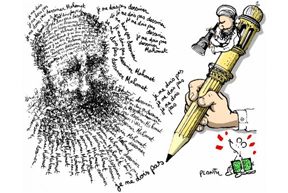Plantu cartoon
Plantu at the time was traveling in the US. He took a call from his editors on Wednesday, February 1, while at a conference in Atlanta, Georgia. Plantu, a professional cartoonist since 1972, had heard of the Danish cartoons much earlier, when they were first published in September 2005. He says he suggested at the time that Le Monde republish them, but his editors declined. Now, with so much emotion stirred up, they still were not eager to republish the original drawings. Plantu agreed with that. He had seen too many instances in which political cartoons had polarized rather than clarified an issue. What happens, he muses, is that “people no longer see the drawing.”
It’s like the portrait of Mohammed. People no longer see the drawing, they see only the humiliation. So is it necessary to show cartoons that make people blind? I’m not sure. [1]
Plantu had no argument with the artist’s right to draw Mohammed. But there was a wider world to consider.
As an artist, I should be able to draw Mohammed without any problem. Only, there is not only the artist to consider. The artist should draw everything, nothing should prevent him. That’s the artist. And then I say to myself—but after all I live on the earth, which is a world at war, it’s not a peaceful world; that artists’ drawings find themselves on the Web; that a drawing can be manipulated; that a drawing can be shown and can be seen as humiliating for millions of Muslims, for example.
Plantu was clear in his view of the political cartoonist’s role. He says that “we have to think about the graphic responsibility of our cartoons. We have a responsibility. We have to use that responsibility. We have to goad, we have to disturb, we have to exacerbate, we have to be violent.” Now he had to act on that code of behavior and decide how to depict the controversy over the Mohammed cartoons. Plantu, who was on his way from Atlanta to the University of Virginia in Charlottesville, ended up sketching on the flight. He recalls:
Considering the drawings, and looking at how they had resonated, I saw it was a good opportunity to respond to intolerance… I remember I was doing something like a punished student: writing I must not draw Mohammed. Like a student. And then I thought whoa, I may have something here. I rearranged the letters. And then I made the pencil. Then I made the hand, because it was the sketcher, I drew the hand that holds the pencil. Then I thought, I can extend this—and I made the minaret. A drawing, you see, is a syntax—not of words, but of symbols. The letters, the bearded man, the pencil, the minaret: voila. Then the words and the symbols speak together—they make a graphic sentence.
Cartoon published . Plantu sent in his cartoon the morning of Thursday, February 2. Kauffmann says she was confident the product would be first rate: “We’ve been working together for so long, he’s so very much a part of our DNA that we know in a situation like this, it’s going to be what we want.” And it was. Recalls Greilsamer:
He sent us this extraordinary illustration which in a certain manner saved all of us because he said everything. It was a very strong statement of our position but it was not aggressive. It was a position which was respectful, which was intelligent. For me, it was a very, very good drawing.

© Jean Plantureux/ Le Monde
The cartoon ran within hours in the edition printed at noon—with the publication date of February 3. The cartoon , which ran on the front page, depicted a giant hand gripping a mammoth pencil, writing over and over the words: “I must not draw Mohammed.” [2] The words spiraled into a portrait of a turbaned man with a flowing beard. At the top of the pencil, shaped like a minaret, a small turbaned figure trained a telescope on the trail of words.
The headline read: “Islam: les caricatures de la discorde” (Islam: the cartoons of discord), and a subhead said “La crise provoquée par la publication de dessins representant Mahomet s’exacerbe” (the crisis provoked by the publication of the cartoons representing Mohammed is growing). The accompanying news story, written by le redaction , reported the growing protests across the globe and that numerous publications in Europe had republished the cartoons.
Le Monde also published an editorial on the dispute on page 2. Called Caricatures libres (free cartoons), it quoted the French Constitution’s Article 1 and went on to say:
Religions are systems of thought, construction of the spirit, beliefs which are respectable but which can be freely analyzed, criticized, ridiculed. It is the same with political ideologies. The republican laity supposes religious neutrality and tolerance. It is necessary to distinguish religions from those who practice them. The latter must be protected against all discrimination and against any abusive language based on their religious adherence.
On page 3, Le Monde ran two more articles on the controversy. One chronicled the views of eight cartoonists. A second story focused on the European publications which had decided to republish the cartoons. Another two news articles on page 5 noted that Denmark feared the “Mohammed affair” would provoke sectarian violence and that French Muslims had denounced the cartoon reproductions in France Soir as a racist act.
And still the controversy refused to die down. Le Monde was obliged to keep coverage intense.
[1] Author’s interview with Jean Plantureux in Paris, on May 20, 2010. All quotes from Plantu, unless otherwise attributed, are from this interview.
[2] “Islam: les caricatures de la discorde,” Le Monde , February 3, 2006, http://www.plantu.net/actu/9-DESSINS-RELIGIONS.pdf.